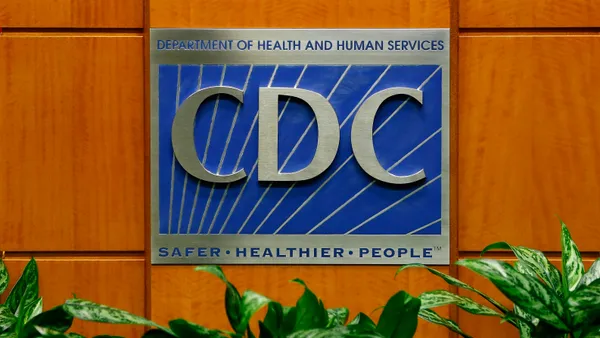COVID-19 has created a virtual environment that is here to stay, and the industry will need to begin to adjust.
From remote working to patient and physician engagement, pharma marketers and sales reps have had to rethink commercial strategies in a virtual landscape. With the onset of COVID, the shift to digital-everything isn’t going to go away, and pharma will need to evolve its interactions along with it.
As we reported last year, (Pharma’s Future in Virtual Healthcare, October 2019) pharma companies have been partnering with tech and data companies to discover ways to best use virtual health and how it can improve processes all 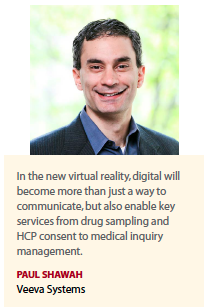 across the business continuum. On the pharma level, virtual health tools will enable the industry to have broader engagement with patients and physicians along multiple touchpoints. From digital tools to help solve problems associated with clinical trials to enhancing R&D, the life-sciences industry is investing in virtual health tools, such as artificial intelligence, machine learning, virtual reality, and augmented reality.
across the business continuum. On the pharma level, virtual health tools will enable the industry to have broader engagement with patients and physicians along multiple touchpoints. From digital tools to help solve problems associated with clinical trials to enhancing R&D, the life-sciences industry is investing in virtual health tools, such as artificial intelligence, machine learning, virtual reality, and augmented reality.
“The buzzword of the day has been virtual engagement, but its definition means different things to different people," says Matt Giegerich, CEO, The Inception Company. “As virtual meetings and events become a staple of the landscape moving forward, we will need to delve deeper into understanding our audiences’ expectations and how to most effectively meet those expectations."
There will be an ever-increasing number of virtual meeting options and for some, web conferences or traditional virtual meetings will meet both their objectives and budget. But those who value the interactions and connectivity of in-person meetings will expect more, i.e., an opportunity to connect with the speakers, the content, and each other in a dynamic environment. To accomplish this, speakers will need to embrace new skill sets and get comfortable interacting with remote participants, speaking with them as if they were in the same room and including them in the discussion. “It will no longer be enough to simply deliver presentations to a remote audience but, rather, it will be incumbent upon the presenters to create a sense of community with their audience to encourage discussion and share insights," Mr. Giegerich says. “Whether it’s physician peer-to-peer discussions, patient advisory boards, clinical trial updates, or salesforce training, the need for face-to-face connection with others will continue to rise."
The biggest challenge in the migration from in-person to virtual will be keeping the integrity of the meeting or event. It will not be sufficient to simply jump on a computer to talk — virtual programs are going to require planning and production in the same way as in-person meetings, giving thought to show flow, real-time interaction, and using tools that facilitate engagement. Hybrid 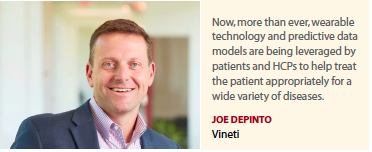 meetings will need to seamlessly integrate the virtual and in-person audiences to create one master event where all participants share the same experience and results.
meetings will need to seamlessly integrate the virtual and in-person audiences to create one master event where all participants share the same experience and results.
“The pandemic has caused us to raise the bar on virtual events and we must continue to do so in the future, recreating or reimagining the elements of in-person meetings to thrive in a virtual world," Mr. Giegerich says.
Long-term digital transformation efforts are well under way across the life-sciences industry, reports Paul Shawah, senior VP of commercial cloud strategy at Veeva Systems.
“In the new virtual reality, digital will become more than just a way to communicate, but also enable key services from drug sampling and HCP consent to medical inquiry management," he says. “Companies will be better placed to meet HCPs on their terms with the information and services they need through any channel, any device, at any time, in every therapeutic area."
Patients will also require a new approach, as the virtual healthcare trend continues.
According to Joe DePinto, chief commercial officer at Vineti, patients have looked to technology to research disease and treatment and they will look to product manufacturers and HCPs to help them achieve this goal.
“Now, more than ever, wearable technology and predictive data models are being leveraged by patients and HCPs to help treat the patient appropriately for a wide variety of diseases," Mr. DePinto says. “Patients want to capitalize on scientific and technology breakthroughs for difficult disease treatment and have the ability to live an active life during treatment."
Marketing Predictions
Ultimately, there will be a list of new tactics and tools for the marketer of the future as this virtual healthcare ecosystem continues to evolve. What will not change is the importance of using data to understand the market segments and message to them appropriately. Additionally, each marketer needs to be customer-centric and have a deep understanding of the challenges and opportunities for their product to best meet the needs of the patient.
Put simply, pharma marketers need to rethink their role in the marketplace, says Craig Moore, executive creative director, multichannel services, Avant Healthcare.
“Where marketing once had the ability to drive the conversation around a therapy or disease state, pharma marketers must now tune in to social media to monitor where the conversation is going and adjust their content accordingly," he says. “They can now think of themselves as shifting from salespeople to content publishers, or creators of highly engaging content that delivers real value to HCPs."
Along with adopting technology, telling good patient stories will also be part of the success equation in the future. In the coming years, pharma marketers will  continue to adopt tech trends — immersive experiences, gamification, and whatever the future brings — but the innovative emphasis will always be on telling customer stories. It’s getting increasingly difficult to “wow" people with technological wizardry, but using those innovative technologies to tell a compelling, authentic story is an approach that will win
continue to adopt tech trends — immersive experiences, gamification, and whatever the future brings — but the innovative emphasis will always be on telling customer stories. It’s getting increasingly difficult to “wow" people with technological wizardry, but using those innovative technologies to tell a compelling, authentic story is an approach that will win  in the future, Mr. Moore says.
in the future, Mr. Moore says.
Marketing professionals will need to be agile and flexible with product positioning going forward to accommodate the new virtual reality — a hybrid model that accounts for, accommodates, and optimizes both remote and live scenarios related to the products being promoted.
Savvy marketers need to accept this new norm of virtual digital interaction and realize that it’s not going away, says Gregory T. Simpson, VP, head of marketing at Saama Technologies. “We must all also embrace the technology that is enabling this new reality or be left behind," he says. “We’re not going back to our pre-pandemic way of doing everything in person."
The future will have a new hybrid virtual and in-person model of interacting. Mr. Simpson says marketers need to ask themselves: What does this mean for my new product launches, my product positioning, how I engage with patients and physicians?
Mr. Simpson notes that “change is the only constant" and marketers must continue to adapt their strategies and tactics to address the ever-changing environment in which target audiences live and work.
Sales Predictions
Another impact of this new virtual era of digital tools is how salesforces will engage with physicians in the future. For example, most HCPs said pharma companies are increasingly providing education on how to better treat patients remotely and help them manage their conditions in light of COVID-19.
Pharma companies are also helping patients understand where they can access labs, infusion centers or imaging centers and offering solutions to HCPs and their practices so they can more easily afford and keep stock of therapies. In the United States, information on affordability programs that pharmaceutical companies offer has been particularly helpful.
According to a report by Accenture, COVID-19 has had a direct impact on HCP behavior and therefore altered the sales rep communication role. Before COVID-19, 64% of HCP meetings with pharma sales reps were held in person.
During the pandemic, this shifted to 65% of meetings held virtually. Many of the HCPs reported that they expect restrictions in access to healthcare facilities will continue for some time — perhaps even permanently. Indeed, 43% of HCPs said they are currently restricting who can enter the office for professional reasons (i.e., no pharmaceutical reps). Twenty-eight percent of those with restrictions said they believe it is something they may implement permanently and another 44% said they would keep the restrictions “for the foreseeable future."
But the report finds that HCPs still want to learn about new treatments and interact with pharma sales reps — they just want to do so in different ways; 88% of the HCPs surveyed said they want to hear about new treatments despite being amidst the pandemic. Four in 10 HCPs said the likelihood of starting a patient on a new treatment has increased, as they have a greater ability to monitor patient response, more access to information on new treatments, and more time to learn about them.
And, in fact, 61% said they are interacting with pharma sales reps more during COVID-19 than they did before. But they want pharma sales reps to have a better understanding of their needs and the needs of their patients. For example, 58% said they have been spammed by a pharmaceutical company.
Mr. Shawah suggests that with in-person access still limited, digital channels like remote meetings, email, and virtual events will complement face-to-face visits in a much bigger way and provide an alternative to better engaging HCPs. There’s been a dramatic shift in the use of remote meetings, for example, as the best way to connect with doctors. The number of virtual meetings has increased nearly nine times, with biopharma companies interacting with hundreds of thousands of HCPs online since March.
“Rep engagements with doctors are lasting longer and are more in-depth — an average 19 minutes versus the typical six-minute sales visit," Mr. Shawah says. “Field teams are also leveraging email more as another convenient and efficient way to connect with doctors. Email is providing reps additional opportunities to stay engaged. In fact, many HCPs prefer email to other forms of engagement."
This shift to digital creates a greater need for more content. When you consider that during a remote meeting, content is used 80% of the time, versus only 20% of the time face-to-face, the industry will have to focus on delivering even more valuable content.
Digital is driving many companies to adopt a modular content approach — or creating bite-sized content that tells a cohesive story, from text and images to graphics, charts, and tailored social media. Modular content will be key for reps to engage in relevant conversations with HCPs at the right time over email or during a remote meeting.
With limited HCP access, the digital opportunity for reps is to stay engaged and 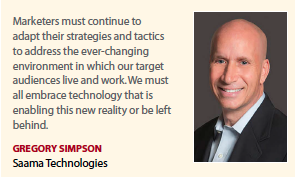 maintain deeper, sustained relationships with customers. And engaging doctors becomes a much more iterative, storytelling approach with modular content.
maintain deeper, sustained relationships with customers. And engaging doctors becomes a much more iterative, storytelling approach with modular content.
This helps sales representatives build upon each HCP engagement and bring customers along their journey in a much more effective way, no matter what their engagement preference is — face-to-face or virtual.
What’s Ahead for Virtual Engagement
The trick is for life-sciences companies to prepare to be adaptable and innovative and take advantage of the many opportunities to thrive in this virtual future. COVID-19 opened the door to digital transformation and now the shift toward remote engagement is gaining serious traction.
With newfound flexibility to engage customers on their terms and get doctors the information they need when they need it, the new virtual reality in life sciences will be its greatest era of effectiveness and efficiency in serving its many customers, Mr. Shawah says.
“But for this virtual reality to take hold, rep relationships will be key to opening the door and sustaining more digital opportunities with HCPs," he adds. “While conventional thinking says that more use of digital channels could lead to fewer salespeople, the rep relationship with HCPs will be key to driving digital adoption, making the role of the rep more important than ever."
There will be some digital natives among doctors who want every engagement to be digital. But how a rep works in the new virtual reality will be much more blended because the majority of HCPs will require a mix of digital and in-person interactions. “The rep relationship will be the difference between sustaining digital engagement or losing it," Mr. Shawah says.
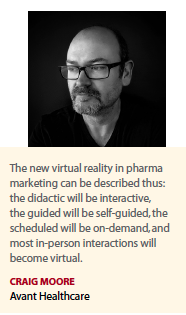 The rep will advance new digital approaches throughout the industry and every organization’s digital success will be tightly linked to the strength of their relationships with HCPs. In turn, Mr. Shawah says, digital will create opportunities for reps to connect with customers they haven’t spoken with for years or reach new customers that were never accessible before.
The rep will advance new digital approaches throughout the industry and every organization’s digital success will be tightly linked to the strength of their relationships with HCPs. In turn, Mr. Shawah says, digital will create opportunities for reps to connect with customers they haven’t spoken with for years or reach new customers that were never accessible before.
The pandemic has been an engine for innovation in pharma marketing and there’s no going back, Mr. Moore adds. “Going into 2021 and beyond, we’re going to see a further democratization of content through things like HCP-focused social media platforms — SERMO, Doximity, and Figure1," he says. “HCPs are now empowered to have whatever discussion about a drug they prefer, and they will likely value that discussion more than any carefully crafted marketing message."
Mr. Moore describes the new virtual reality in pharma marketing like this: the didactic will be interactive, the guided will be self-guided, the scheduled will be on-demand, and most in-person interactions will become virtual.
Forced into more use by the pandemic, the possibilities for a better future through virtual and digital methods are limitless, unlike traditional face-to-face meetings and events.
Through virtual, pharma can provide pertinent content to specific audiences, giving them a much better chance of reaching the desired target audience.(PV)
~~~~~~~~~~~~~~~~~~~~~~~~~
A Shift in the Mix
According to a recent Accenture survey, there has been a positive shift in the pharma/physician engagement dynamic.
Key Finding No. 1
COVID-19 is driving lasting changes in what healthcare providers need and value.
Key Finding No. 2
Pharma companies are starting to redefine their relevance in this new landscape, and healthcare providers are seeing the value.
Key Finding No. 3
Virtual engagement with pharma field reps is here to stay, requiring new ways of creating meaningful connections.







